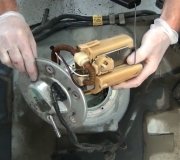You have to crawl underneath and look for the leak. If the entire area is wet and the leak is rather slow, you may need to wash the area first with engine degreaser, then rinse it with water, and dry it. Start the engine, then you might need to have a helper slowly turn the steering wheel back and forth. You do not have to turn it far or fast. It simply needs to be moving for the pump to start putting pressurized fluid in the hose.
The location of the puddle on the ground is a good starting point, but be aware, due to the nature of how rack and pinion assemblies are bolted in, fluid can run along and inside the front cross member and drip out at an entirely different area.
The first thing to look at is the high-pressure hose. Once washed and dried, the two common places to look are the metal tubes crimped to the ends, and for a split along the hose. Watch for fluid oozing out and running down the hose.
The next, more common suspect is the steering gear itself. Typically a rack seal will leak fluid into one of the flexible accordion boots around an inner tie rod end. There is an air transfer pipe slid into and connecting the two boots. Fluid will flow through that pipe into the second boot. It can take up to about two quarts of fluid to fill those boots, then the fluid will get pushed out the small end on one or both sides.
When there is an obvious loss of fluid, but with no puddle or wet area, suspect the rack seal is leaking, but the boots have not filled up yet. To identify that, slide off one of the hose clamps on the small end of one of the boots, then use a small pick with a right-angle hook on the end to pull that boot open a little. If fluid comes running out, the rack must be replaced.
When the leak is too slow to wait for while watching underneath, consider adding a small bottle of dark purple dye to the power steering fluid. Search after driving a few minutes, an hour, or a day, as appropriate, with a black light. The dye will show up as a bright yellow stain that you can follow back to the source. This is not real effective with fast leaks because the entire area will be wet, and glowing yellow.
Auto parts stores will have the bottles of dye for the fluid being tested, and those that rent or borrow tools should have a black light.
Monday, January 29th, 2018 AT 4:02 PM
(Merged)



